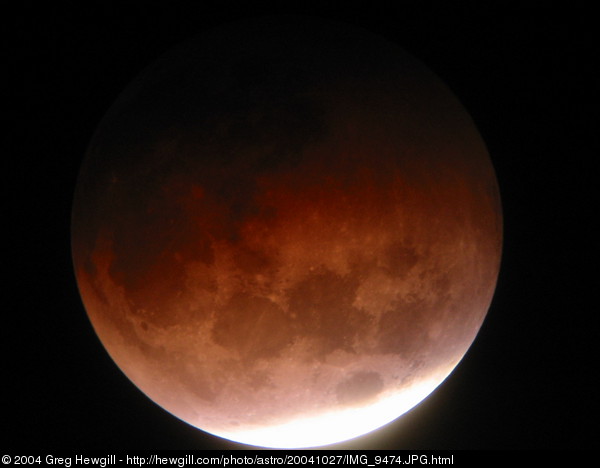Last year I was disappointed to have missed an opportunity to photograph a lunar eclipse (I ended up getting some lightning pictures the next day instead). This time, I specifically made sure I was going to be home, and hoped that the weather would clear up enough to see it.
The sky was cloudy most of the day, but not completely. Fortunately, the skies cleared up for me enough to get some pictures. I set up my telescope on my back porch, brought the laptop outside, and sat outside for over three hours during the entire eclipse, taking pictures and watching it myself.
The clouds came and went, but there was enough opportunity to get some good views. My camera battery died about 60 seconds before totality started; I ran around and found two other batteries that were also dead. I put one on the charger and some clouds rolled in, which made me feel better about missing that part. Once those clouds cleared, I got some (dark) pictures of totality.
My equipment is a Takahashi FS-102 (4" refractor) with an 18 mm eyepiece and a Canon S110 digital camera.
2004-10-28T13:29:11Z
Of course, they're all on long rolls because every lab refuses to cut them. Word of advice: shoot a couple of waaaaaaay overexposed frames so the lab has a reference point in which to cut.
2004-10-28T21:03:19Z
2004-10-28T12:42:49Z
Lunar eclipse. Red Sox wins the world series. Who could ask for a better evening?
2004-10-28T13:25:55Z
2004-10-28T13:31:14Z
2004-10-28T13:57:35Z
2004-10-28T16:26:32Z
2004-10-28T17:37:26Z
2004-10-28T19:54:48Z
"Those were pretty good pictures for that kind of camera. Did he build a custom mount for it as it doesn’t look like that kind of camera was made to fit on a telescope.
The questions that I have are :
Is there a good digital SLR camera that will allow me to take long exposures (on the order of 30 minutes) ?
How does a good SLR compare to a CCD imager that was made for telescopic photos ?
Does he recommend any particular method – CCD vs Digital Camera
I have a Meade LX200 10” that I would like to use to take pictures, and I’m looking for a good solution. If I can use an SLR digital camera, then that would be my first choice."
2004-10-28T21:04:17Z
For stellar photography, where there is much less light available, my camera isn't sufficient. For that kind of digital photography, you don't necessarily need to keep the shutter open for a long time. You can instead take lots of shorter exposure pictures and then use a technique called "stacking" to merge them into one composite photo. This is not really possible with film photography, so you have to take long exposures.
Modern digital SLR cameras probably outperform many CCD imagers, but on the other hand a good CCD imager is quite expensive and has important features like a cooling system (usually a Peltier cooler) to cut down on CCD noise. I don't have either (yet), so I can't really make any objective statements here.
The LX200 will certainly allow you to take astounding photographs. To use a digital SLR camera, you need a "T" adapter for your telescope (visit Austin Astronomy) and a "T" adapter for your camera (visit any camera store). In fact, there is a great image of Saturn on Austin Astronomy's home page taken with an 8" scope and a webcam.
Good luck, and if you have any further questions feel free to ask!
2004-10-28T21:45:43Z
Use a webcam + eyepiece adapter. Here’s an example of a cheap adapter on Ebay: http://cgi.ebay.com/ws/eBayISAPI.dll?ViewItem&category=74926&item=3848620689&rd=1&ssPageName=WDVW Search the internet and you will find a bunch of photos and info on this method. Pros:cheap. Cons: Need to lug around a laptop. Lots of post processing required in order to obtain decent results, and results will never be optimal. Only really any good for bright objects (sun/moon/planets). But you can get some very reasonable results for planets because of the noise (electrical and atmospheric perturbations) canceling techniques used during the post processing phase. http://www.webcam-astrophotography.com/
Use a digital camera eyepiece adapter. I bought one for my Olympus C-5050 from these guys: http://www.scopetronix.com/ Again, you are looking at taking multiple exposures because the CCDs used in digicams are not very low noise. Even a 5 minute exposure on my 5 megapixel C5050 has too much noise. Again, mainly sun/moon/planets. Pros: higher resolution, convenient (no laptop), and not too expensive. Cons: too much CCD noise for real time exposures like you will need to resolve M1, etc.
Use a real astrophotography CCD. These are typically inherently low noise CCDs that are then peltier cooled. Pros: this is what the “pros” use ; ) Cons: Laptop required. Pricey brand new, but can be had cheaper on Ebay with low use on them. In fact, someone is selling one right now!! http://cgi.ebay.com/ws/eBayISAPI.dll?ViewItem&category=31745&item=5930453233&rd=1&ssPageName=WDVW However, keep in mind that this is a monochromatic CCD. The color CCDs like those used in digicams are too noisy. So you have to take 3 discrete exposures with red, green, and blue filters respectively and then assemble them with software later UNLESS you also get the automatic color wheel (pictor 616). If you have that, press a button and the filters auto rotate into place, pictures are taken, then auto-assembled for you. The color filters are harder to find used, and about $700 new. One source: http://www.bhphotovideo.com/bnh/controller/home?O=productlist&A=details&Q=&sku=202949&is=REG But if you can get the CCD and autoguider that’s for sale on Ebay now + the color wheel for $700 you will have a kick ass system for WAYYYYY cheaper than these combos sold for initially. The 416xt/216AG/616 combo originally sold for about $2800
2004-10-30T19:20:21Z
2004-11-27T00:24:51Z
These are really nice shots - I'd like to see you post them to the group and explain the "how you did it" aspect.
Thanks!
(I'll add you back in a few minutes)
2007-11-11T22:35:44Z

2004-10-28T12:10:21Z